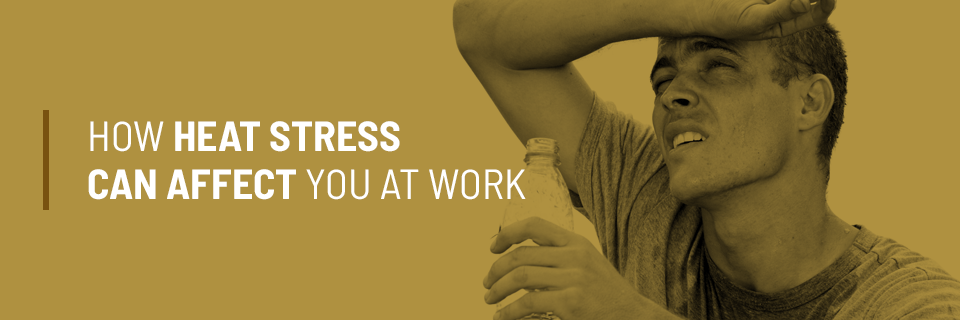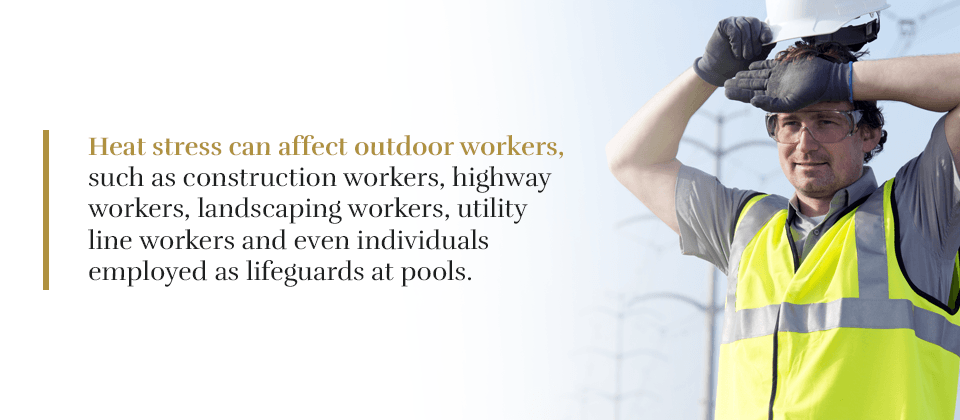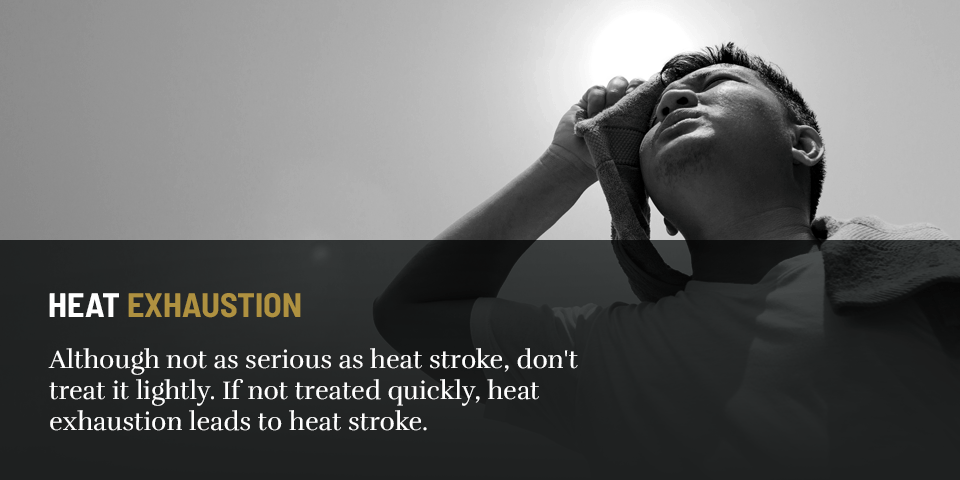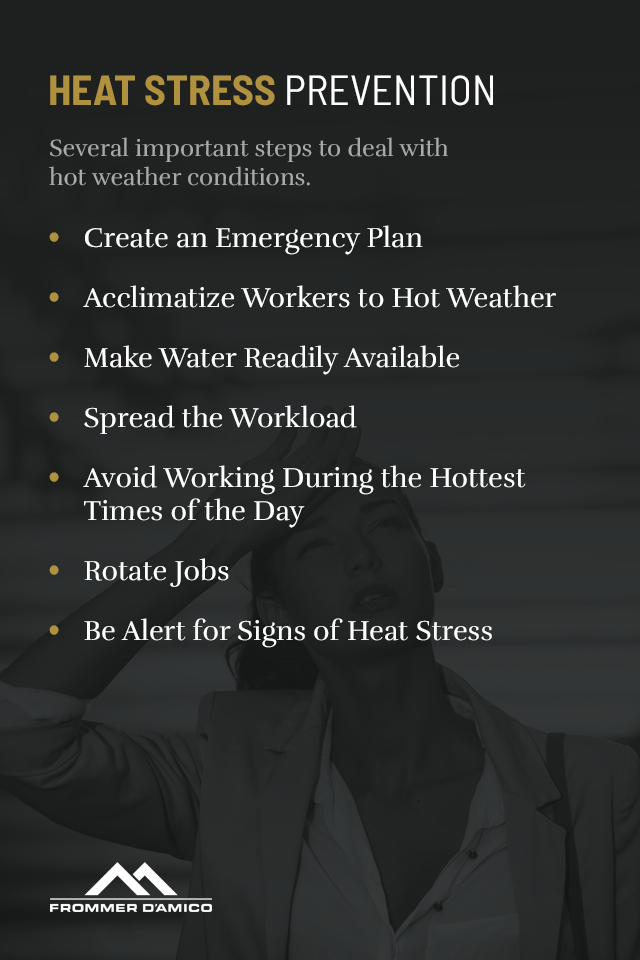Table of Contents
If you think summers have been getting warmer over the past few years, you aren’t wrong. According to Science Magazine, summers are heating up faster in areas of North America than they are in other parts of the globe.

Regardless of the reason for this rise in temperature, hotter weather means a greater risk of heat stress for workers in Pennsylvania. Employees who work outside face the most immediate danger, but heat stress can affect any workers in extremely hot facilities.
As summer months continue to grow warmer, the threat to workers increases.
What Is Heat Stress?
Heat stress, also known as hyperthermia, results when the body is exposed to extreme heat and cannot properly cool itself. This results in the rapid rise of body temperature.
Normally, sweat is how humans remove body heat. When humidity is high, however, which often happens in hot weather, sweat does not evaporate as quickly as it does when the temperatures are cooler. This prevents the body from quickly releasing excess heat.
Although heat stress can affect anyone, it most commonly affects people who are:
- 65 years of age or older
- Overweight individuals
- Individuals who have existing medical problems, such as heart disease, diabetes or respiratory illnesses like asthma
- Individuals who are socially isolated
As we noted, however, it’s not just older people who are susceptible to heat stress. Many young and healthy individuals can fall victim if they are engaged in strenuous physical activities in hot weather. For instance, there are frequently stories in the media about young college athletes who succumb to heat stress, such as the young football player at the University of Maryland several years ago.
Drinking too much alcohol in hot weather or taking medications that affect your body’s ability to regulate its internal temperature are also causes of heat stress.
Heat stress is a concern for workers in Pennsylvania. Anyone exposed to heat or who works in very hot temperatures is vulnerable. Heat stress can affect outdoor workers, such as construction workers, highway workers, landscaping workers, utility line workers and even individuals employed as lifeguards at pools. It’s not just outdoor workers, however, who can be affected by extremely hot temperatures. Employees who work indoors in facilities where high temperatures are common, especially in summer, are as much at risk.
Heat stress can affect workers in more ways than just causing conditions like heatstroke or heat rash. High temperatures can result in sweaty palms, which may lead a worker to drop a tool from a height, or fogged safety glasses, making it harder for workers to see properly. High temperatures can often lead to dizziness, which is a danger for any worker but especially those working at heights.
Common Heat Stress Symptoms
Heat stress can manifest itself in several different conditions.
1. Heatstroke
This is the most serious heat stress-related condition. Signs of heatstroke include:
- Skin that is hot and dry or shows signs of profuse sweating
- An altered mental state, confusion or slurred speech
- Seizures
- Rapid pulse
- Loss of consciousness, usually fainting but in severe cases a coma
- Elevated body temperature usually over 103°F
- Death if not treated promptly
2. Heat Exhaustion
This is the body’s reaction to an excessive loss of salt and water due to profuse sweating. Workers most at risk for heat exhaustion include older workers, those who have high blood pressure or those working in an extremely hot environment. Symptoms include:
- Dizziness
- Headache
- Nausea
- Irritability
- Weakness in arms and legs
- Fast heartbeat
- Profuse sweating
- Thirst
- Elevated body temperature
- Reduced urine output
3. Rhabdomyolysis
This is a heat stress condition caused by prolonged physical exertion in extremely hot temperatures. It results in the death of muscle tissue. When muscle tissue dies, it releases elements into the bloodstream that lead to irregular heart rhythms, seizures and possible damage to the kidneys. Symptoms include:
- Muscle pain and cramps
- Dark urine — the color of tea or cola
- An intolerance for exercise
- Weakness
Unfortunately, rhabdomyolysis can also be asymptomatic.
4. Heat Syncope
This is an episode of fainting or dizziness that often happens after a worker has been standing for a long period or gets up suddenly after sitting in one position or lying in one position for a long time. This may be caused by dehydration or a failure to acclimatize to the hot weather. Symptoms include:
- Short duration fainting
- Dizziness
- Feeling lightheaded when standing for a long time or arising suddenly
5. Heat Cramps
This is also a condition caused by prolonged physical activity in hot weather but is not as severe as rhabdomyolysis. Symptoms include:
- Muscle spasms
- Pain in the abdomen, arms or legs
6. Heat Rash
This is a skin irritation caused by profuse sweating in hot, humid weather. Symptoms include:
- Clusters of red pimples or small blisters
- These clusters of blisters will appear on the neck, under the breasts, on the upper chest or in the creases of elbows.
How Heat Stress Can Affect You
When a worker is exposed to extreme heat conditions, this can lead to some of the illnesses we mentioned above or exacerbate pre-existing conditions such as heart problems or respiratory conditions such as asthma. In fact, it can be difficult for medical authorities to determine if a worker has died as a result of a heat-related illness for exactly this reason. Heat stress often exacerbates other conditions, which may make it appear as if these conditions were the cause of death when the main cause was actually the prolonged exposure to high temperatures and humidity.
1. Heat Exhaustion
Although not as serious as heat stroke, don’t treat it lightly. If not treated quickly, heat exhaustion leads to heat stroke. This can cause damage to the brain and other vital organs. In some cases, untreated heat exhaustion can lead to death. Heat exhaustion is more likely when the humidity is over 60%.
2. Heatstroke
As we mentioned above, this is the most serious of all the heat-related illnesses. If left untreated, heatstroke can cause multiple organ failure and death.
3. Heat Rash
While heat rash may be a minor heat stress injury, it can also be one of the most uncomfortable. The small blisters or clusters of red pimples caused by heat rash can make it difficult for a worker to accomplish any task in hot weather, whether indoors or outdoors. Working becomes very painful in these conditions and could become dangerous.
4. Heat Cramps
These involuntary, painful muscle spasms occur during heavy exercise or strenuous physical activity in hot weather. The spasms can be quite intense. In comparison to leg cramps at night, these cramps last longer and are more painful.
5. Heat Syncope
This is also known as orthostatic dizziness. This happens during the initial days a worker may be exposed to extremely hot weather. It occurs when an individual does not have enough blood flow to the brain, which causes them to faint. This can be particularly bad for any worker whose job requires them to work on a hot day at an elevated height, such as construction work on a building or a utility worker on a telephone pole.
6. Rhabdomyolysis
This is another severe heat-related illness. When muscle cells break down and leak into the blood during strenuous physical activity in hot weather, rhabdomyolysis can lead to coma, kidney problems, multiple organ failure and possibly death. In less serious cases, it can lead to limb weakness, making it difficult for a worker to maintain their hold on tools or to maintain their positions during work.
Heat Stress Prevention
If employers want to make sure that their workers are protected against heat stress-related illnesses, they can take several important steps to deal with hot weather conditions.
1. Create an Emergency Plan
Create an emergency plan about the process to take if a worker has shown signs of heat-related injury or illness and how to contact medical services if they are needed.
2. Acclimatize Workers to Hot Weather
It’s critical to help workers acclimatize to hot weather if their jobs require them to work during these conditions. Employers should take steps to help their workers by gradually increasing workloads from day-to-day and allowing more frequent breaks, especially during the first week of work. This is vital for workers who have never had to work in hot weather or who have been off the job for several days.
3. Make Water Readily Available
Workers required to do their jobs in hot weather conditions must have access to lots of safe drinking water. It needs to be close to the work areas. Workers need to remember not to gulp the water but to sip it frequently in small amounts.
4. Spread the Workload
When workers are required to work in hot conditions, when it is at all possible, they should be allowed to evenly distribute their workload over their shifts. They should also be allowed to take more frequent breaks.
5. Avoid Working During the Hottest Times of the Day
When the weather is extremely hot, employers should try to arrange a worker’s schedule so that they are either working during cooler periods of the day or given lighter tasks during the hottest time of the day while saving more strenuous work for cooler periods.
6. Rotate Jobs
Employers can often reduce the chances of heat stress among workers if they allow the workers to rotate their job functions.
7. Be Alert for Signs of Heat Stress
Employers should teach their employees how to recognize the signs of heat-related illnesses so workers can keep an eye on each other for symptoms of heat stress during hot weather. They should also know how to administer the proper first aid to anyone showing signs of a heat-related illness.
What You Should Do If You’re Subject to Heat Stress at Work
The General Duty Clause of the Occupational Safety and Health Act (OSHA) states that employers must provide employees with a place of employment that is “free from recognizable hazards” that may cause them harm or even death. This has been interpreted by courts over the years to mean that an employer has a legal obligation to provide a workplace that the employer knows is free of hazardous conditions and that may cause or are likely to cause serious physical harm or death. This includes hazardous conditions like extremely hot weather that leads to heat-related illnesses that could cause severe bodily harm or death.
Employers in Pennsylvania are required to follow OSHA guidelines to protect their workers from heat stress. Also, the Pennsylvania Department of Labor and industry offers a presentation on heat-related illnesses for employers and employees that shows how to recognize the signs of heat stress and how to prevent them. It advises employers that if their employees need to work outside in hot weather and high temperatures, they should avoid working in direct sunlight between the hours of 10 AM and 4 PM, wear a hat with a brim, apply sunscreen with SPF 30 or higher and use eye protection and rest in the shade.
If a worker believes their employer is not doing enough to protect them from heat stress in the workplace, they may file a complaint with OSHA and ask them to inspect their workplace. OSHA will check to see if there is a serious hazard to employees’ health or if the employer is not following the correct OSHA rules. OSHA protects the identities of all those who file complaints.
Workers also have the right under the law to raise health and safety concerns with their employer or with OSHA. Workers can file a complaint with OSHA if they believe that their employer has retaliated against them for exercising these rights.
Contact Frommer D’Amico Today If You Have Suffered a Heat-Related Illness or Injury on the Job
As the weather gets warmer and temperatures climb, the chances of suffering a heat-related illness or injury grows. If you’ve had to work in extremely hot weather and those conditions have led you to develop heat stroke, heat exhaustion or some other heat-related illness, you may be eligible to receive workers’ compensation benefits. You should talk to the experienced attorneys at Frommer D’Amico today. Our team of experienced and knowledgeable attorneys specializes in workers’ compensation issues.
If you believe you have suffered a work-related illness or injury connected to having to work in hot temperatures, see us for a free consultation. You can call us at 717-400-1000 or visit our contact us page where you can tell us how to get a hold of you and leave us a little information about your situation. A member of our team will get back to you as soon as possible.




